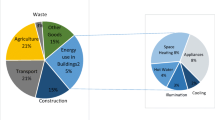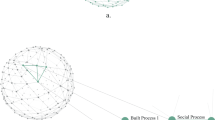Abstract
Covid-19 rapidly highlighted the significance of good public health, similarly, showing that our built environment is crucial in responding to global challenges. Through the lens of Building Back Better, and with a continued focus on health, this paper presents a literature and rapid sco** review examining the extent to which the relationship between our Health, the circular economy, and our Built Environment has recently been investigated. Building Back Better is a future risk mitigation strategy focused on establishing resilient communities. Circular economy has been explored as one such vehicle towards develo** economic, social, and environmental resiliency. Circular economy is a systems’ solution framework, aimed at breaking the linear ‘extract, use, dispose’ model. Circular economic advantages are largely emphasised from the perspective of effective and sustainable production and consumption: with the ramifications for health receiving comparatively little attention. Despite this, a circular transition may offer potentially considerable health benefits, while simultaneously contributing societal resiliency, and numerous UN Sustainable Development Goals. The study finds that the implications of the circular economy on health are largely under-explored and highlights significant gaps in the literature regarding the health outcomes of a transition to a circular economy in the built environment. It concludes that while the circular economy presents a viable option for building resilience, it also calls for more systematic investigation to fully understand the potential health and social impacts of circular transition in the built environment. The paper also notes that the uptake of the circular economy remains relatively slow and further research is required to understand its social and health impacts.
Access this chapter
Tax calculation will be finalised at checkout
Purchases are for personal use only
Similar content being viewed by others
References
Araujo Galvão GD, de Nadae J, Clemente DH et al (2018) Circular economy: overview of barriers. Procedia CIRP 73:79–85. https://doi.org/10.1016/J.PROCIR.2018.04.011
Arksey H, O’Malley L (2007) Sco** studies: towards a methodological framework. 8:19–32. https://doi.org/10.1080/1364557032000119616
Arup, BAM, CE100 (2017) Circular business models for the built environment. Arup, BAM & CE100 1–25
Bäunker L, Haigh L (2020) Covid-19 and the circular economy: opportunities and reflections | by circle economy | circle economy | medium. https://medium.com/circleeconomy/covid-19-and-the-circular-economy-opportunities-and-reflections-7c2a7db70900. Accessed 30 Sep 2022
Çimen Ö (2021) Construction and built environment in circular economy: a comprehensive literature review. J Clean Prod 305:127180. https://doi.org/10.1016/J.JCLEPRO.2021.127180
Crane M, Lloyd S, Haines A et al (2021) Transforming cities for sustainability: a health perspective. Environ Int 147
Daszak P (2012) Anatomy of a pandemic. The Lancet 380:1883–1884. https://doi.org/10.1016/S0140-6736(12)61887-X
Ellen Macarthur Foundation (2017) Cities in the circular economy: an initial exploration
Ellen MacArthur Foundation, McKinsey Center for Business and Environment (2015) Growth Within: a circular economy vision for a competitive Europe | shared by business
Ghisellini P, Ripa M, Ulgiati S (2018) Exploring environmental and economic costs and benefits of a circular economy approach to the construction and demolition sector. A literature review. J Clean Prod 178:618–643. https://doi.org/10.1016/j.jclepro.2017.11.207
Hart J, Adams K, Giesekam J, et al (2019) Barriers and drivers in a circular economy: The case of the built environment. In: Procedia CIRP. Elsevier B.V., pp 619–624
Hassler U, Kohler N (2014) Resilience in the built environment. 42:119–129. https://doi.org/10.1080/09613218.2014.873593
Ibn-Mohammed T, Mustapha KB, Godsell J et al (2021) A critical analysis of the impacts of COVID-19 on the global economy and ecosystems and opportunities for circular economy strategies. Resour Conserv Recycl 164:105169. https://doi.org/10.1016/J.RESCONREC.2020.105169
IMF, World Bank (2021) Global Outlook. Global Econ Prospects 1–55. https://doi.org/10.1596/978-1-4648-1665-9_CH1
Kirchherr J, Piscicelli L, Bour R et al (2018) Barriers to the circular economy: evidence from the European Union (EU). Ecol Econ 150:264–272. https://doi.org/10.1016/J.ECOLECON.2018.04.028
Kucukvar M, Kutty AA, Al-Hamrani A, et al (2021) How circular design can contribute to social sustainability and legacy of the FIFA World Cup Qatar 2022TM? The case of innovative ship** container stadium. Environ Impact Assess Rev 91. https://doi.org/10.1016/j.eiar.2021.106665
Lacy P, Rutqvist J (2016) Waste to wealth: the circular economy advantage
Megahed NA, Ghoneim EM (2020) Antivirus-built environment: Lessons learned from Covid-19 pandemic. Sustain Cities Soc 61:102350. https://doi.org/10.1016/j.scs.2020.102350
Mhatre P, Gedam V, Unnikrishnan S, Verma S (2021) Circular economy in built environment—literature review and theory development. J Build Eng 35
Morris C, Rogerson D (2011) Research guides: rapid review protocol: steps: rapid review. Anaesthesia 66:819–827. https://doi.org/10.1111/J.1365-2044.2011.06775.X/FULL
Morse SS, Mazet JAK, Woolhouse M et al (2012) Prediction and prevention of the next pandemic zoonosis. The Lancet
Mossin N, Bøjstrup TC, da Costa Vasconcelos T, Jensen JZ (2022) Pandemiens arkitektur, 1st edn. Realdania
Nations Office for Disaster Risk Reduction U (2015) Sendai framework for disaster risk reduction 2015–2030
Osobajo OA, Oke A, Omotayo T, Obi LI (2022) A systematic review of circular economy research in the construction industry. Smart Sustain Built Environ 11:39–64
Perchinunno P, Mongelli L, Rotondo F (2020) A multidimensional approach for the identification of environmental and health wellness territories. Ecol Indic 110. https://doi.org/10.1016/j.ecolind.2019.105911
Pham MT, Rajić A, Greig JD, et al (2014) Asco** review of sco** reviews: advancing the approach and enhancing the consistency. https://doi.org/10.1002/jrsm.1123
Pinner D, Rogers M, Samandari H (2020) Addressing climate change in a post-pandemic world
Pinter-Wollman N, Jelic A, Wells NM (2018) The impact of the built environment on health behaviours and disease transmission in social systems. Philos Trans Royal Soc B: Biol Sci 373. https://doi.org/10.1098/rstb.2017.0245
Pitkänen K, Kaisa T, Karppinen M et al (2020) Sex, drugs and the circular economy: the social impacts of the circular economy and how to measure them. In: Handbook of the circular economy, pp 162–175
Ranta V, Aarikka-Stenroos L, Ritala P, Mäkinen SJ (2018) Exploring institutional drivers and barriers of the circular economy: a cross-regional comparison of China, the US, and Europe. Resour Conserv Recycl 135:70–82. https://doi.org/10.1016/J.RESCONREC.2017.08.017
Roof K, Oleru N (2008) Public health: Seattle and King County’s push for the built environment. 71
ScienceDirect.com | Science, health and medical journals, full text articles and books. https://www.sciencedirect.com/. Accessed 11 Oct 2022
Stahel WR (2016) The circular economy. Nature 531:435–438. https://doi.org/10.1038/531435a
Stockholm Resilience Centre (2016) Through resilience thinking towards sustainability and innovation: recommendations for policy makers in the EU. Stockholm
UN DESA (2020) Policy brief series: responding to COVID-19 and recovering Better
Vanhuyse F, Fejzić E, Ddiba D, Henrysson M (2021) The lack of social impact considerations in transitioning towards urban circular economies: a sco** review. Sustain Cities Soc 75. https://doi.org/10.1016/j.scs.2021.103394
WHO (2020a) Listings of WHO’s response to COVID-19. In: World Health Organization. https://www.who.int/news/item/29-06-2020-covidtimeline. Accessed 11 Mar 2022
WHO (2020b) Coronavirus disease (COVID-19)
WHO (2022) WHO coronavirus (COVID-19) dashboard | WHO coronavirus (COVID-19) dashboard With vaccination data.https://covid19.who.int/. Accessed 29 Sep 2022
WHO (2018) Circular economy and health: Opportunities and risks
WHO (2019) Assessing the health impacts of a circular economy
Wu T, Perrings C, Kinzig A et al (2017) Economic growth, urbanization, globalization, and the risks of emerging infectious diseases in China: a review. Ambio 46:18–29
Author information
Authors and Affiliations
Corresponding author
Editor information
Editors and Affiliations
Rights and permissions
Copyright information
© 2023 The Author(s), under exclusive license to Springer Nature Switzerland AG
About this paper
Cite this paper
Da Costa Vasconcelos, T. (2023). Health, the Circular Economy, and Our Built Environment. In: Hasan, A., Benimana, C., Ramsgaard Thomsen, M., Tamke, M. (eds) Design for Health. UIA 2023. Sustainable Development Goals Series. Springer, Cham. https://doi.org/10.1007/978-3-031-36316-0_7
Download citation
DOI: https://doi.org/10.1007/978-3-031-36316-0_7
Published:
Publisher Name: Springer, Cham
Print ISBN: 978-3-031-36315-3
Online ISBN: 978-3-031-36316-0
eBook Packages: EngineeringEngineering (R0)




